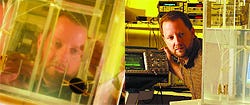Research Center Expands Testing Capabilities to Help Reduce Interference
September 7, 2006
Originally Published MPMN September 2006
INDUSTRY NEWS
Research Center Expands Testing Capabilities to Help Reduce Interference
|
GTRI Senior Research Engineer Ralph Herkert monitors the output of a pacemaker, which is mounted in a torso simulator in Georgia Tech's EAS/Medical Device E3 Test Center. The saline-filled tank simulates the environment experienced by a device implanted in a human chest. (Georgia Tech Photo: Gary Meek) |
For more than a decade, Georgia Tech’s EAS/Medical Device E3 Test Center (GTRI; Atlanta; www.gtresearchnews.gatech.edu) has been helping manufacturers improve compatibility between implantable medical devices and systems that radiate electromagnetic energy. These sources of energy include electronic article surveillance (EAS) systems that help retailers, libraries, and other establishments prevent theft and track inventory.
Recently, the Center has expanded its operations to test new types of security and logistical systems, including radio-frequency identification (RFID).
Typically, manufacturers use filters to reduce electromagnetic interference, but medical devices pose special challenges. The operating frequencies and modulation characteristics of EAS systems and tag deactivators can fall in the same frequency band as biological signals such as the heartbeat. Filters would not only eliminate the EAS signals but also the very signals that medical devices are designed to detect.
RFID systems could also be potential emission threats to medical devices. For example, more companies are using RFID systems for inventory control. Right now, these devices typically are found on warehouse and shipping containers. Yet, as costs decline, RFID technology may soon show up in stores on individual products.
In response, GTRI is acquiring RFID systems, which will be set up and used with its electronic article surveillance (EAS) testing protocols.
“As RFID becomes ubiquitous, testing medical devices against RFID readers and active tags in all frequency ranges will be an essential growth area of the EAS/Medical Device E3 Test Center,” says Gisele Bennett, director of GTRI’s Electro-Optical Systems Lab, which oversees the Center.
Researchers at the Center simulate real-world conditions by placing a device in a tank of saline solution that simulates the electrical characteristics of body tissue and fluid. The tank then moves along a track that exposes the device to nine EAS systems and five tag deactivators that use various types of magnetic, acoustic-magnetic, and radio-frequency technologies.
Several tests are performed with the device placed in different orientations to represent how people might interact with EAS field emissions. Manufacturers use the resulting data to improve products and make sure they meet FDA requirements.
The Center tests a variety of medical devices including implantable hearing aids, drug-infusion pumps, neurostimulators, cardiac monitors, and glucose monitors. And because a patient may use more than one product, possible interactions between different devices are also evaluated.
Copyright ©2006 Medical Product Manufacturing News
You May Also Like


.png?width=300&auto=webp&quality=80&disable=upscale)
